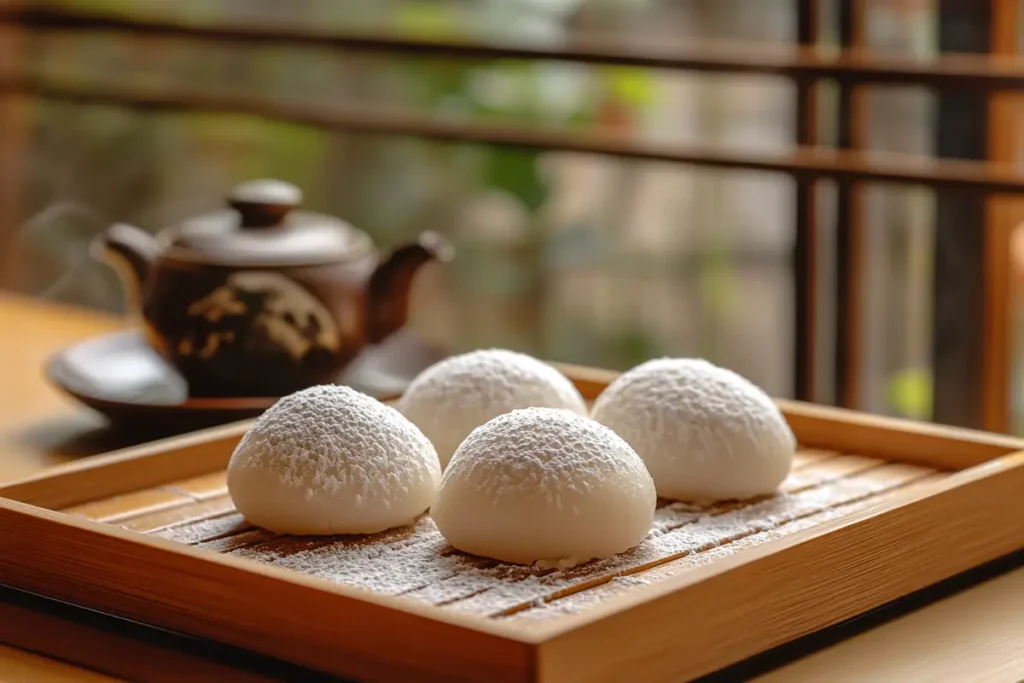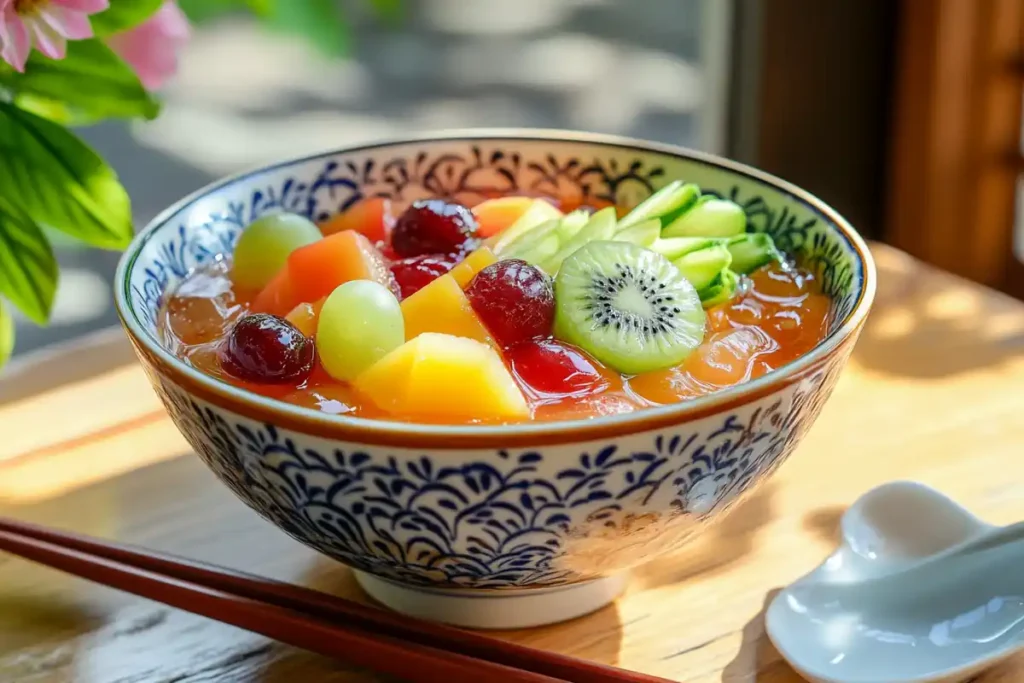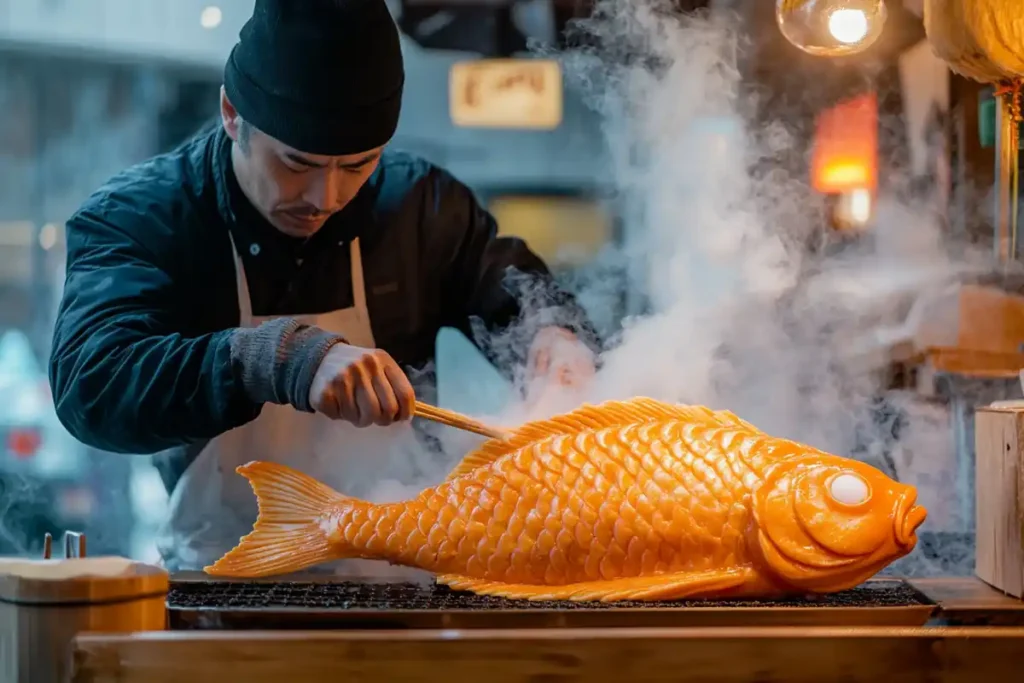What is the most popular dessert in Japan? Japan boasts a unique cuisine that blends tradition with modernity in every bite. Desserts, in particular, showcase the country’s deep cultural roots and creative flair. From chewy mochi to the creamy decadence of Japanese cheesecake, every dessert tells a story. This article explores the most popular desserts in Japan, highlighting both traditional and modern creations that captivate hearts worldwide. So, grab a cup of tea and immerse yourself in the sweet side of Japan!
Traditional Japanese Desserts (Wagashi)
Mochi: The Quintessential Japanese Treat

Mochi is undeniably one of the most iconic Japanese desserts. This chewy rice cake, made from glutinous rice, has been a staple in Japanese culture for centuries. It’s not just a dessert—it’s a symbol of celebration, particularly during New Year’s festivities and other special occasions.
The process of making mochi, called mochitsuki, captivates onlookers. People rhythmically pound steamed glutinous rice with a mallet in a large wooden mortar to create its stretchy, sticky texture. But don’t let its simplicity fool you—mochi’s versatility enables it to take on various forms and flavors.
Variations of Mochi
- Daifuku: Perhaps the most beloved variation, daifuku consists of mochi filled with a sweet filling, typically anko (red bean paste). Modern versions sometimes include strawberries or even ice cream for a delightful twist.
- Sakuramochi: This pink-hued delight features a pickled cherry blossom leaf as its wrapping and symbolizes spring’s arrival during the cherry blossom season.
- Kusa Mochi: Infused with yomogi (Japanese mugwort), this green mochi boasts a subtly herbal flavor that complements its sweetness.
Anmitsu: A Refreshing Summer Delight

When summer hits Japan, locals turn to anmitsu for a refreshing treat. This traditional dessert is a harmonious blend of agar jelly cubes, sweet red bean paste, fresh seasonal fruits, and a drizzle of kuromitsu (black sugar syrup). It’s a light, cooling dish that perfectly balances textures and flavors.
While the base ingredients remain consistent, anmitsu often sees regional twists, such as the addition of ice cream, mochi balls, or green tea-flavored jelly. It’s no wonder this dessert has stood the test of time—it’s like a little bowl of summer.
Dorayaki: A Pancake Sandwich
If pancakes are your jam, you’re going to love dorayaki. This treat features two fluffy pancakes sandwiched with a filling of sweet anko. The batter includes a touch of honey, giving the pancakes a golden hue and a slightly caramelized flavor.
Thanks to its simple yet satisfying taste, dorayaki has become a favorite among both children and adults. Interestingly, it also gained fame as the favorite snack of Doraemon, the beloved Japanese cartoon character, solidifying its place in pop culture.
Taiyaki: The Fish-Shaped Cake

Shaped like a fish and filled with delicious fillings, taiyaki is a crowd favorite at Japanese festivals and street stalls. Sweet red bean paste traditionally fills it, but newer variations include custard, chocolate, and even savory fillings like cheese
The crispy exterior contrasts beautifully with the warm, gooey filling, making every bite a delightful experience. Whether enjoyed as a snack or dessert, taiyaki is a must-try for anyone exploring Japanese cuisine.
Dango: Skewered Rice Dumplings
Another beloved wagashi is dango, chewy rice dumplings served on skewers. Cooks make these small, round balls from rice flour and often grill them, which lends a slightly charred flavor.
- Mitarashi dango features a glaze of soy sauce and sugar, creating a sweet and savory contrast.
- Hanami dango, a tri-colored version, is a staple during cherry blossom festivals.
Served warm or at room temperature, dango pairs perfectly with a cup of green tea.
Modern Japanese Desserts (Yōgashi)
Matcha Parfait: A Fusion Dessert
Japanese culinary culture loves experimenting, and the matcha parfait is a perfect example of tradition meeting modernity. Layered with components like matcha-flavored ice cream, sponge cake, whipped cream, and even mochi balls, this dessert is a visual and flavorful delight.
The vibrant green of matcha (powdered green tea) lends the parfait its signature appearance. It looks stunning and delivers a unique, earthy flavor that balances perfectly with the sweetness of the other ingredients. Served in elegant glasses, matcha parfaits are a staple in cafes and dessert shops, loved by both locals and tourists alike.
Japanese Cheesecake: Light and Fluffy
Unlike its Western counterpart, Japanese cheesecake features a light, airy texture. People often call it soufflé cheesecake or cotton cheesecake because it practically melts in your mouth. Bakers achieve its fluffy consistency by incorporating whipped egg whites into the batter.
Its subtle sweetness and delicate flavor make it the perfect dessert for those who prefer less sugary treats. Best served chilled, Japanese cheesecake pairs wonderfully with tea or coffee. Over the years, it has gained international popularity, becoming a symbol of Japan’s unique dessert innovations.
Purin: Japanese Crème Caramel
If you’re a fan of custard desserts, purin (Japanese crème caramel) is a must-try. This smooth and creamy treat is made with simple ingredients: eggs, milk, sugar, and a touch of vanilla. Topped with caramel sauce, purin offers a delightful contrast between its rich custard base and the bittersweet caramel.
What makes purin unique is its slightly firmer texture compared to traditional Western puddings. It’s often sold in small glass containers, making it a convenient and beloved snack for children and adults alike.
Kakigōri: Shaved Ice Dessert
For those hot summer days, kakigōri is unbeatable. This traditional shaved ice dessert exemplifies an art form with its fine, snow-like texture and creative flavor combinations. Vendors drizzle syrups like matcha, strawberry, or yuzu over the ice and often accompany it with toppings like condensed milk, red bean paste, or mochi balls.
Modern interpretations of kakigōri have become increasingly elaborate, with some versions incorporating fresh fruit, whipped cream, or even edible flowers. It’s more than just a dessert—it’s a refreshing escape from the summer heat and a visual feast.
Regional Japanese Desserts
Japan’s rich culinary diversity is not only reflected in its savory dishes but also in its desserts. Each region offers unique confections, often shaped by local ingredients and traditions. Let’s take a sweet journey through some iconic regional desserts.
Hokkaido’s Cream Puff (Shū Cream)
Hokkaido, Japan’s dairy haven, is famous for its shū cream (cream puffs). These light, airy pastries are filled with rich, velvety custard cream, often made with locally sourced milk and butter. The result? A perfectly balanced dessert that’s neither too sweet nor too heavy.
Hokkaido’s emphasis on high-quality dairy ensures that these cream puffs stand out. Variations include fillings like matcha cream, chocolate custard, and even seasonal fruit-flavored creams. Whether enjoyed fresh at a bakery or packed as a souvenir, shū cream is a regional delight you can’t miss.
Kyoto’s Yatsuhashi: A Cinnamon-Flavored Treat
Kyoto, steeped in history and tradition, offers yatsuhashi, a dessert that embodies the city’s refined culture. Made from glutinous rice flour, yatsuhashi comes in two forms: baked and unbaked.
- Baked Yatsuhashi: Crispy and thin, this version resembles a wafer cookie with a subtle cinnamon flavor.
- Unbaked Yatsuhashi: Known as nama yatsuhashi, it’s soft and pliable, often wrapped around fillings like sweet red bean paste or matcha-flavored cream.
As a popular souvenir from Kyoto, yatsuhashi captures the city’s essence in every bite. Its delicate flavors pair beautifully with green tea, making it a staple of tea ceremonies and gift-giving.
Nagasaki’s Castella Cake
Nagasaki is famous for its castella cake (or kasutera), a sponge cake introduced to Japan by Portuguese merchants in the 16th century. Over time, the Japanese refined the recipe to create a dessert that’s light, moist, and perfectly sweet.
The cake’s simplicity—made with eggs, sugar, flour, and starch syrup—belies its incredible flavor and texture. Often baked in long rectangular pans, castella has a golden-brown top and a fluffy, tender interior. Some variations include matcha or honey for added depth.
When visiting Nagasaki, you’ll find shops offering beautifully packaged castella, making it a perfect gift or travel keepsake.
Japanese Dessert Etiquette and Culture
Japanese desserts, or wagashi, are much more than sweet treats—they’re deeply embedded in the country’s cultural fabric. From their role in traditional tea ceremonies to their seasonal significance, these confections reflect Japan’s reverence for nature, aesthetics, and harmony.
The Art of Wagashi in Tea Ceremonies
In Japan, tea ceremonies (chanoyu) are about more than just drinking tea—they’re an immersive cultural experience emphasizing mindfulness, elegance, and simplicity. Wagashi plays an essential role in these ceremonies, offering a sweet contrast to the bitterness of matcha (powdered green tea).
- Designs Reflecting Seasons: Each piece of wagashi is a work of art, crafted to represent the current season. For example, in spring, sweets may resemble cherry blossoms, while autumn-inspired confections might depict maple leaves.
- Texture and Flavor Balance: The mild sweetness of wagashi enhances the flavor profile of matcha, creating a perfect harmony of tastes.
The pairing of wagashi with tea embodies omotenashi—the Japanese spirit of hospitality—and underscores the importance of savoring the moment.
Seasonal Significance of Japanese Sweets
Seasonality, or shun, is a cornerstone of Japanese culture, influencing everything from fashion to food. Desserts are no exception, with specific treats marking the transition of the seasons.
- Spring: Sakuramochi and hanami dango are enjoyed during cherry blossom season, celebrating renewal and beauty.
- Summer: Kakigōri and anmitsu provide a refreshing escape from the heat.
- Autumn: Desserts like kurikinton (sweet chestnut paste) and kaki yokan (persimmon jelly) reflect the harvest season.
- Winter: Warm treats like manjū (steamed buns filled with sweet bean paste) are comforting during colder months.
This seasonal approach to desserts highlights Japan’s connection to nature and the changing times of the year, reminding people to appreciate life’s fleeting moments.
Frequently Asked Questions (FAQs)
To wrap up our exploration of Japanese desserts, let’s address some commonly asked questions to deepen your understanding of these sweet delights.
1. What is the most popular dessert in Japan?
Mochi is often considered the most popular dessert in Japan. Its versatility, cultural significance, and widespread availability make it a favorite among locals and tourists alike. Variations like daifuku and sakuramochi are especially beloved.
2. Are Japanese desserts always sweet?
Not necessarily! Many Japanese desserts, such as wagashi, have a subtle sweetness that’s less sugary than Western treats. This delicate balance is intentional, designed to complement the flavors of green tea or other beverages.
3. What makes Japanese cheesecake different?
Japanese cheesecake features a light, airy texture and a less sugary flavor. People often call it soufflé cheesecake or cotton cheesecake because of its soft, fluffy consistency, which makes it unique compared to Western-style cheesecakes.
4. Are Japanese desserts vegan-friendly?
Some traditional Japanese desserts, like yokan (sweet jelly made from red bean paste and agar), are naturally vegan. However, many modern desserts, such as shū cream or purin, contain dairy. Always check the ingredients to be sure.
5. What’s the best dessert to try for someone new to Japanese sweets?
For beginners, dorayaki is an excellent choice. Its soft pancakes and sweet red bean filling are approachable yet distinctly Japanese. Alternatively, matcha parfait offers a blend of traditional and modern flavors.
6. Where can I buy authentic Japanese desserts outside Japan?
Japanese grocery stores, specialty Asian supermarkets, and online retailers often stock a variety of authentic Japanese desserts. Many cities also have Japanese bakeries or cafes where you can try freshly made treats.
Print
Matcha Mochi Cake
- Total Time: 50 minutes
- Yield: 9 squares (serves 9) 1x
Description
This Matcha Mochi Cake is a delightful Japanese-inspired dessert with a chewy, bouncy texture and the earthy, slightly sweet flavor of matcha green tea. Made with glutinous rice flour, it’s naturally gluten-free and pairs wonderfully with a cup of green tea or as a unique treat for gatherings.
Ingredients
- Dry Ingredients:
- 1 ½ cups glutinous rice flour (sweet rice flour)
- ¾ cup granulated sugar
- 2 teaspoons matcha powder
- 1 teaspoon baking powder
- Wet Ingredients:
- 1 cup coconut milk (unsweetened)
- ½ cup whole milk (or plant-based alternative)
- 1 large egg
- ¼ cup unsalted butter, melted and cooled
- 1 teaspoon vanilla extract
- Optional Topping:
- Powdered sugar for dusting
- Whipped cream or sweet red bean paste (anko)
Instructions
- Preheat the Oven:
Preheat your oven to 350°F (175°C). Grease an 8×8-inch (20×20 cm) baking pan or line it with parchment paper for easy removal. - Mix Dry Ingredients:
In a large mixing bowl, whisk together the glutinous rice flour, sugar, matcha powder, and baking powder until evenly combined. - Prepare Wet Ingredients:
In a separate bowl, whisk the coconut milk, whole milk, egg, melted butter, and vanilla extract until smooth. - Combine Ingredients:
Gradually pour the wet ingredients into the bowl of dry ingredients. Stir until the batter is smooth and lump-free. - Bake the Cake:
Pour the batter into the prepared baking pan and smooth the top with a spatula. Bake in the preheated oven for 40–50 minutes, or until the top is lightly golden and a toothpick inserted into the center comes out clean. - Cool and Serve:
Allow the cake to cool in the pan for at least 30 minutes. Once cooled, remove from the pan and dust with powdered sugar or serve with your choice of topping.
Notes
- For a more intense matcha flavor, you can increase the matcha powder by ½ teaspoon.
- Store leftovers in an airtight container at room temperature for up to 2 days, or refrigerate for up to 5 days.
- Ensure you use glutinous rice flour, not regular rice flour, for the chewy mochi texture.
- Prep Time: 10 minutes
- Cook Time: 40 minutes
- Category: Dessert
- Method: Baking
- Cuisine: Japanese
Nutrition
- Serving Size: 1 square
- Calories: 180
- Sugar: 15g
- Sodium: 40mg
- Fat: 7g
- Saturated Fat: 5g
- Unsaturated Fat: 2g
- Trans Fat: 0g
- Carbohydrates: 26g
- Fiber: 1g
- Protein: 2g
- Cholesterol: 25mg
Keywords: Matcha Mochi Cake, Gluten-Free Dessert, Japanese Dessert, Easy Mochi Recipe

